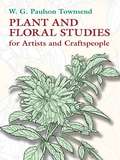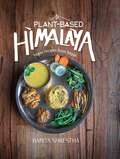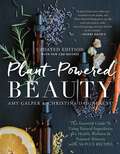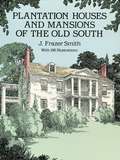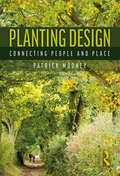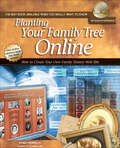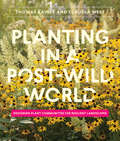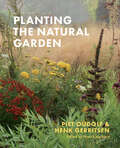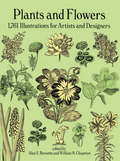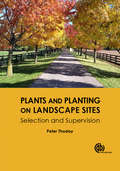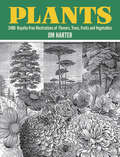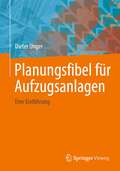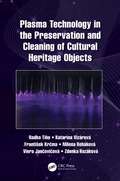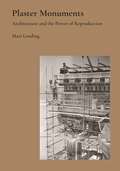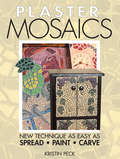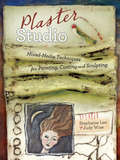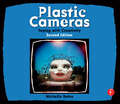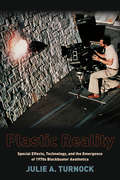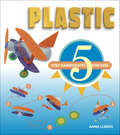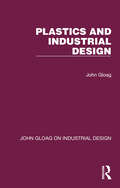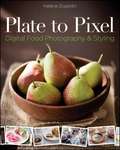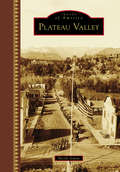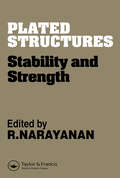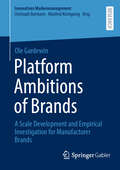- Table View
- List View
Plant and Floral Studies: for Artists and Craftspeople
by W. G. TownsendRemarkably broad in its applications, this helpful reference covers a wide variety of plants. More than 100 precise drawings of flowers, leaves, buds, and growth patterns are provided for such plants as the anemone, arbutus, broad bean, bell-flower, briar rose, campanula, canterbury bell, dahlia, and lily; a detailed narrative provides descriptions of physical features and general botanical information for each plant.Invaluable for making stencils, needlework canvases, and other floral design projects, this thoroughly illustrated, comprehensive guide will be a boon to amateur and professional artists, art students, and crafters.
Plant-Based Himalaya: Vegan Recipes from Nepal
by Babita ShresthaThe art of healthy cooking is all about loving yourself and spreading that love to those around you. It's even better when you can cook a delicious meal and also help protect the environment. In Plant-Based Himalaya, Nepalese author Babita Shrestha shares 38 vegan recipes from her home country that she has been cooking and eating since she was very young, including mouthwatering grains, dal, curries, greens, sauces, and desserts. In addition to food, Shrestha introduces her beloved Nepal along with her personal goals for a plant-based diet: decreasing mass production and consumption of unhealthy processed food in plastic packaging. Featuring 250 beautiful full-color photos, Plant-Based Himalaya is designed to inspire you to cook and eat exquisitely vegan home-style Nepali cuisine. Make it exceptional, and share it with your loved ones!
Plant-Powered Beauty, Updated Edition: The Essential Guide to Using Natural Ingredients for Health, Wellness, and Personal Skincare (with 50-plus Recipes)
by Amy Galper Christina DaigneaultYou know your diet should be rich in plants for optimal health. So shouldn't the products you apply to your skin, which are absorbed into your body, also be filled with plants? If you've ever looked at the back of your so-called "natural" facial moisturizer or body cream and seen a list of complicated additives you couldn't recognize or pronounce, then you know firsthand that mass-produced synthetic beauty products can be something of a mystery. With Plant-Powered Beauty: The Essential Guide to Using Natural Ingredients for Health, Wellness, and Personal Skincare (with 50-plus Recipes), harness the power of plant-based energy to maintain your natural beauty and let your skin glow like never before. Natural beauty experts Amy Galper and Christina Daigneault show readers how to deconstruct beauty labels, parse ingredients lists, make informed choices about the products they use—and, most important, better understand how their skin works. At the heart of Plant-Powered Beauty, you will find more than 50 easy-to-follow recipes to make your own plant-based skincare and beauty products, such as: Almond Milk Facial Cleanser Anti-aging Facial Scrub Blemish Gel Choc-o-Mint Lip Balm Coconut Whip Makeup Remover Vitamin-Rich Hair Health Serum Quick and Fresh Cucumber-Thyme Body Scrub Moisturizing Body Oil for Super-Dry Skin Natural Mouthwash Plus, in this updated edition of Plant-Powered Beauty, meet the hottest wellness and beauty ingredient: cannabidiol, a very unique molecule within the Cannabis sativa plant. Research shows that CBD has a remarkable effect on the skin, including supporting tissue repair, evening skin tone, and promoting a youthful glow. New CBD recipes—for men and women!—include a salve to reduce pain, bath soak to address inflammation, facial serum for balancing, roll-on for stress relief, body butter, and more. Plant-Powered Beauty unlocks sought-after wisdom for all aspects of plant-based personal skincare and celebrates the shift in beauty trends, bringing us back to natural beauty and reconnecting us with plants and healthy choices.
Plantation Houses and Mansions of the Old South
by J. Frazer SmithIn this profusely illustrated book the reader will "journey through a wide section of the South with an architect as ... companion: from Lexington to Nashville, then along the Natchez Trace and down the great Mississippi River to New Orleans, with little by-way excursions to homes set back from the main highways." Embracing a variety of styles -- from pioneer cabins to French Provincial and Neoclassic revivals -- the houses described here recall a bygone era of gracious living and aristocratic privilege.Over 100 detailed illustrations, including 36 floor plans, depict such venerable residences as The Hermitage, Andrew Jackson's white-pillared homestead near Nashville; Annandale, a Mississippi mansion in the Italian Renaissance style; Rosedown, the Greek-revival state in Louisiana where John James Audubon completed Birds of America; Belle Alliance, a splendid plantation house of wrought iron and white pillars; the lovely Gothic chapel of Old Jefferson College, and many more. The author has provided a rich commentary on each house, offering colorful historical anecdotes and perceptive architectural analysis, along with additional material on carpentry, masonry, the portico, staircases, and other topics.Architects will find this an especially revealing tour of the building styles and technical features of the great homes of the Old South. But general readers will also find it an insightful and absorbing look at a time long past in the lower Mississippi Valley, when the stately white-pillared mansions of the well-to-do graced the Southern landscapes and provided a bastion of security, comfort, and prosperity in a vast and promising new land.
Planting Design: Connecting People and Place
by Patrick MooneyLandscape designers have long understood the use of plants to provide beauty, aesthetic pleasure and visual stimulation while supporting a broad range of functional goals. However, the potential for plants in the landscape to elicit human involvement and provide mental stimulation and restoration is much less well understood. This book meshes the art of planting design with an understanding of how humans respond to natural environments. Beginning with an understanding of human needs, preferences and responses to landscape, the author interprets the ways in which an understanding of the human-environment interaction can inform planting design. Many of the principles and techniques that may be used in planting design are beautifully illustrated in full colour with examples by leading landscape architects and designers from the United Kingdom, Europe, North America and Asia, including: Andrea Cochran, Andrea Cochran Landscape Architecture, San Francisco, CA Design Workshop Inc. Richard Hartlage, Land Morphology, Seattle, WA Shunmyo Masuno, Japan Landscape Consultants Ltd., Yokohama Piet Oudolf, Hummelo, The Netherlands Melody Redekop, Vancouver Christine Ten Eyck, Ten Eyck Landscape Architects Inc., Austin, TX Kongjian Yu, Turenscape Ltd., Beijing. The book stimulates thought, provides new direction and assists the reader to find their own unique design voice. Because there are many valid processes and intentions for landscape design, the book is not intended to be overly prescriptive. Rather than presenting a strict design method and accompanying set of rules, Planting Design provides information, insight and inspiration as a basis for developing the individual designer’s own expression in this most challenging of art forms.
Planting Your Family Tree Online: How to Create Your Own Family History Web Site
by Cyndi HowellsA beginner’s guide to building a website that traces your family’s lineage as a resource for present and future generations, or for finding new relatives.Planting Your Family Tree Online is designed to take you step-by-step through the process of creating a genealogy Web site.When people begin their genealogical adventure, they usually interview elderly members of the family and contact other family members. The next step is usually one of organization of the information collected. The third step is usually to share this information with other family members, traditionally by publishing research in a book. However, a family Web site has numerous advantages:It is interactive so others can contribute their stories and pictures.It will help you find long-lost relatives.It is an ideal way to preserve research for the entire family.It will break down the walls that have stumped you in your research.It recognizes that family research is an ongoing processThis book is written by Cyndi Howells, owner and webmaster of Cyndi’s List, a Web site of more than 130,000 online genealogical resources. Cyndi points out, “This book is loaded with URLs to Web sites that will give you everything you need to create a beautiful family tree online.” However, Web site URLs change daily and some may no longer work. She has created web pages as part of Cyndi’s List that correspond to the features of the book so that the URLs will be kept up-to-date.
Planting in a Post-Wild World: Designing Plant Communities for Resilient Landscapes
by Thomas Rainer Claudia West“As practical as it is poetic. . . . an optimistic call to action.” —Chicago Tribune Over time, with industrialization and urban sprawl, we have driven nature out of our neighborhoods and cities. But we can invite it back by designing landscapes that look and function more like they do in the wild: robust, diverse, and visually harmonious. Planting in a Post-Wild World by Thomas Rainer and Claudia West is an inspiring call to action dedicated to the idea of a new nature—a hybrid of both the wild and the cultivated—that can flourish in our cities and suburbs. This is both a post-wild manifesto and practical guide that describes how to incorporate and layer plants into plant communities to create an environment that is reflective of natural systems and thrives within our built world.
Planting the Natural Garden
by Piet Oudolf Henk Gerritsen“If the world of gardening has rock stars, Piet Oudolf qualifies as Mick Jagger, David Bowie, and Prince rolled into one.” —Gardenista The original publication of Planting the Natural Garden ushered in a revolution in landscape design: the New Perennial Movement. Spearheaded by internationally renowned designer Piet Oudolf, and incisively articulated by the late plantsman and designer Henk Gerritsen, it transformed private and public spaces with its emotionally resonant, naturalistic use of hardy perennials and grasses. Now this classic has been expanded and updated to include scores of new plants and combinations. Packed with practical information and visual inspiration, Planting the Natural Garden zeroes in on the New Perennial Movement’s power to move us, making its distinctive plant palette available to all. For enthusiasts of these vibrant landscapes, it is an essential text; for gardeners who love the dreamy moods and colors that Oudolf and Gerritsen celebrate, it’s the key to a magic kingdom of garden beauty.
Plants and Flowers: 1761 Illustrations for Artists and Designers (Dover Pictorial Archive Ser.)
by Alan E. Bessette William K. ChapmanThis comprehensive archive offers authentically detailed, copyright-free illustrations of hundreds of plants and flowers from around the world. Ideal for graphic artists, designers, and others in the arts and crafts, it will also serve both serious and casual botanists as a convenient reference and key to identification of a broad range of botanical species. Each illustration has been carefully selected from botanical archives for its scientific accuracy, artistic style, and suitability for reproduction. The plants and flowers are grouped by kind, uses, and habitats into seventeen categories, among them aquatic plants, carnivorous plants, grasses, rushes and sedges, orchids, ornamental plants, plants of commerce, mushrooms, molds and lichens, ferns, mosses, trees, shrubs, weeds, wildflowers, and vines. For easy and accurate reference, both common and botanical Latin names are given for each species whenever possible. All names have been compiled into two convenient indexes. Alan E. Bessette, Professor of Biology at Utica College of Syracuse University, is a well-known naturalist, botanical photographer, and author of numerous books and field guides on botanical subjects. William K. Chapman, a biology teacher and member of the adjunct faculty at Utica College, is a well-known speaker and writer on the gathering of wild foods, and the author of field guides to plants and animals of the Adirondacks.
Plants and Planting on Landscape Sites
by Peter R. ThodayLandscape architects, design professionals and contractors alike require a good working knowledge of how to achieve plant establishment under a variety of conditions and situations. Overlooking the physiological needs of plants can lead to potential problems that can have negative financial and design impacts. Plants and Planting on Landscape Sites is a practical book giving practitioners in landscape design the essential horticultural knowledge and concepts needed to understand the limits of the material they are working with and make informed decisions. From specification to supervision, this book provides concrete advice along with practical examples for each stage of a typical project. It contains sections on: the landscape site; selecting, assessing and purchasing plants; understanding nursery practice; forms and types of transplant traded; seeds and direct seeding; pre-planting site work; transplanting; and care in the establishment phase. Specially commissioned high quality line diagrams and full colour photographs are used throughout to demonstrate meaning and give examples. Peter Thoday is an experienced consultant, international lecturer in landscape management, and past president of The Institute of Horticulture, who has had numerous roles in high-profile projects, such as Horticultural Director of the Eden Project. Written by an expert, this book is as an essential tool for landscape architects, project managers, contractors and nursery managers.
Plants: 2,400 Royalty-Free Illustrations of Flowers, Trees, Fruits and Vegetables
by Jim HarterHundreds of plant species -- from lilies, lichens, and palms to mushrooms, mosses, and maples -- supplemented by appendices on edible plants, medicinal herbs, and plants used in decoration and in graphic design. Indispensable source of inspiration and royalty-free graphics for designers and artists; a captivating compendium for botanists, gardeners, and collectors of old engravings.
Planung und Gestaltung einer Positivfabrik als Beitrag für eine absolute Nachhaltigkeit (AutoUni – Schriftenreihe #162)
by Malte GeblerDas Konzept einer „Positivfabrik“ beschreibt die Vision, dass Fabriken und ihre Wertschöpfungsprozesse eine nachhaltige Entwicklung in der Biosphäre und in menschlichen Gesellschaften fördern. Positive Fabriken agieren daher als Impulsgeber für nachhaltige Lebensräume, indem sie Ökosysteme schützen, soziale Angebote bereitstellen und eine gemeinwohlorientierte wirtschaftliche Entwicklung unterstützen. Die Planung und Gestaltung einer Positivfabrik erfordert eine methodische und prozessuale Systematik, die der Autor strukturiert herleitet. Die inhaltliche Beschreibung des Prototyps einer Positivfabrik und die Konzeptanwendung verdeutlichen, wie eine Positivfabrik in der Praxis realisiert werden kann.
Planungsfibel für Aufzugsanlagen: Eine Einführung
by Dieter UngerDie Planungsfibel soll für Architekten und Aufzugsplaner Hinweise geben, was bei der Planung einer Aufzugsanlage in einem Neubau, beim Bauen im Bestand und bei einer Modernisierung zu beachten ist. Die Fibel ersetzt keine Planung, sie soll aber als Hilfestellung dienen, Fehler zu vermeiden. Darüber hinaus soll durch Aufklärung einige im Markt vorhandene Missverständnisse beseitigt werden. Hierbei fließen meine eigenen Erfahrungen ein, die ich bei Planungsvorhaben in der Vergangenheit gewonnen habe.
Plasma Technology in the Preservation and Cleaning of Cultural Heritage Objects
by Radko Tiňo Katarína Vizárová František Krčma Milena Reháková Viera Jančovičová Zdenka KozákováScientists have long been looking for alternative methods for the cleaning of historical and cultural museum objects as conventional methods often fail to completely remove surface films, leaving contamination and surface residues behind. Low-temperature plasmas have recently been found to provide a new, efficient and durable approach that maintains the safety of both the materials and personnel. This book is the first to introduce the emerging use of low-temperature plasmas in the cleaning and decontamination of cultural heritage items. It provides a comprehensive exploration of the new possibilities of cleaning objects with plasma, before providing a practice guide to the individual cleaning methods and an overview of the technologies and conditions used in the different cleaning regimes. It is an ideal reference for researchers in plasma physics, in addition to professionals working in the field of historical and cultural conservation. Features: Provides a thorough overview of the cleaning potential of emerging plasma technologies in accessible language for professional restorers and conservators without a scientific background Includes the latest case studies from the field, which have not been published elsewhere yet Authored by a team of experts in the field
Plaster Monuments: Architecture and the Power of Reproduction
by Mari LendingWe are taught to believe in originals. In art and architecture in particular, original objects vouch for authenticity, value, and truth, and require our protection and preservation. The nineteenth century, however, saw this issue differently. In a culture of reproduction, plaster casts of building fragments and architectural features were sold throughout Europe and America and proudly displayed in leading museums. The first comprehensive history of these full-scale replicas, Plaster Monuments examines how they were produced, marketed, sold, and displayed, and how their significance can be understood today.Plaster Monuments unsettles conventional thinking about copies and originals. As Mari Lending shows, the casts were used to restore wholeness to buildings that in reality lay in ruin, or to isolate specific features of monuments to illustrate what was typical of a particular building, style, or era. Arranged in galleries and published in exhibition catalogues, these often enormous objects were staged to suggest the sweep of history, synthesizing structures from vastly different regions and time periods into coherent narratives. While architectural plaster casts fell out of fashion after World War I, Lending brings the story into the twentieth century, showing how Paul Rudolph incorporated historical casts into the design for the Yale Art and Architecture building, completed in 1963.Drawing from a broad archive of models, exhibitions, catalogues, and writings from architects, explorers, archaeologists, curators, novelists, and artists, Plaster Monuments tells the fascinating story of a premodernist aesthetic and presents a new way of thinking about history’s artifacts.
Plaster Mosaics
by Kristin PeckBring the beauty and elegance of ancient mosaics into the modern world - a place where anyone can create them. Learn how in this exciting reference that teaches even beginners to utilize common plaster compound techniques to create 15 mosaic works of art that will fool all but the most discerning eye. Simple techniques are used to apply the plaster to different surfaces, from boxes and frames to furniture. The designs are then transferred to the medium and carved with a simple wire tool. The materials are few and the cost is slim, but the result is spectacular. Projects include a serving tray, cabinet, door hanger, flowerpot, and chalkboard.
Plaster Studio: Mixed-Media Techniques for Painting, Casting and Carving
by Stephanie Lee Judy WiseReturn to the origin of the earth and discover a new way of playing in the mud. Raw, friendly and easily altered, plaster is perhaps the most versatile art medium you have yet to encounter. Beautiful in its luminosity, yet open to receiving a multitude of alterations, plaster will easily agree to being painted, carved, cast and sculpted. Stephanie Lee and Judy Wise will walk you through 24 step-by-step projects and will introduce you to a variety of plaster forms. The techniques you'll be introduced to will inspire you to go on and develop your own creations. Inside Plaster Studio you will discover how to: Apply image transfers to a plaster surface Make plaster projects glow with the addition of encaustic medium Create book pages and covers from plaster Add depth with plaster and stencils Cast objects from plaster that are easy to add to other works of art Bring three-dimensional intrigue to projects using wire armature with plaster gauze Take your work to the next level with the help of inspiring gallery works from the authors and talented contributingartists Mix up your first batch of plaster today and see what Plaster Studio will inspire your imagination to carve out!
Plastic Cameras: Toying with Creativity
by Michelle BatesTake a tour of the burgeoning world of plastic cameras and low-tech photography in this fun and funky guide to creating the most artistic pictures of your life! Whether you're an experienced enthusiast or toy camera neophyte, you'll find this guide full of tantalizing tips, fun facts, and absolutely striking photographs taken with the lowest tech tools around. You'll learn how to prep your plastic camera, their advantages and quirks, and what film to feed it. You'll also explore what makes a good subject, vignetting, multiple exposures, panoramas, close-ups, night photography, color, flash, problems and solutions, and so much more. Michelle Bates also takes you from a negative to either prints or pixels so that you can show off your photos and jump on the toy-camera revolution! Contributors include: Michael Ackerman, Thomas Michael Alleman, Erin Antognoli, Jonathan Bailey , James Balog, Michelle Bates, Phil Bebbington, Gyorgy Beck, Susan Bowen, Laura Corley Burlton, David Burnett, Susan Burnstine, Nancy Burson, Perry Dilbeck, Jill Enfield, fotovitamina, Annette Elizabeth Fournet, Brigitte Grignet, Eric Havelock-Bailie, Christopher James, Michael Kenna, Wesley Kennedy, Teru Kuwayama, Louviere & Vanessa, Mary Ann Lynch, Anne Arden McDonald, Ted Orland, Sylvia Plachy, Dan Price, Becky Ramotowski, Nancy Rexroth, Francisco Mata Rosas, Richard Ross, Franco Salmoiraghi, Rosanna Salonia, Jennifer Shaw, Nancy Siesel, Mark Sink, Kurt Smith, Sandy Sorlien, Pauline St. Denis, Harvey Stein, Gordon Stettinius, Ryan Synovec, Rebecca Tolk, Marydorsey Wanless, Shannon Welles, Matthew Yates, Dan Zamudio
Plastic Reality: Special Effects, Technology, and the Emergence of 1970s Blockbuster Aesthetics (Film and Culture Series)
by Julie TurnockJulie A. Turnock tracks the use and evolution of special effects in 1970s filmmaking, a development as revolutionary to film as the form's transition to sound in the 1920s. Beginning with the classical studio era's early approaches to special effects, she follows the industry's slow build toward the significant advances of the late 1960s and early 1970s, which set the stage for the groundbreaking achievements of 1977. Turnock analyzes the far-reaching impact of the convincing, absorbing, and seemingly unlimited fantasy environments of that year's iconic films, dedicating a major section of her book to the unparalleled innovations of Star Wars and Close Encounters of the Third Kind. She then traces these films' technological, cultural, and aesthetic influence into the 1980s in the deployment of optical special effects as well as the "not-too-realistic" and hyper-realistic techniques of traditional stop motion and Showscan. She concludes with a critique of special effects practices in the 2000s and their implications for the future of filmmaking and the production and experience of other visual media.
Plastic: 5-Step Handicrafts for Kids (5-Step Handicrafts for Kids)
by Anna LlimosIn just five simple steps, children can make fun, memorable crafts out of plastic, including an octopus, a hairy bug, a puppet theater, and gifts for friends. Fourteen projects make clever use of plastic items we find in our everyday lives, such as cups, plates, hair curlers, and drinking straws. Children five years and older will develop fine motor skills, feed their creativity, and be encouraged to find new uses for items we often see as disposable.
Plastics and Industrial Design (John Gloag On Industrial Design Ser.)
by John GloagOriginally published in 1945, Plastics and Industrial Design is a non-technical work of reference for manufacturers and designers who, after the Second World War were beginning to realize the possibilities that manufacturing with Plastics could bring. The different types of plastics and their uses is discussed, as is their impact on the design of manufactured articles. Whilst the extensive use of plastic may have fallen out of favour in recent years due to environmental concerns, this book reminds us that in their infancy they offered exciting manufacturing possibilities.
Plate to Pixel
by Helene DujardinTips and techniques for making food look good--before it tastes good!Food photography is on the rise, with the millions of food bloggers around the word as well as foodies who document their meals or small business owners who are interested in cutting costs by styling and photographing their own menu items, and this book should serve as your first course in food photography. Discover how the food stylist exercises unique techniques to make the food look attractive in the finished product. You'll get a taste of the visual know-how that is required to translate the perceptions of taste, aroma, and appeal into a stunning, lavish finished photograph.Takes you through the art and techniques of appetizing food photography for everyone from foodies to food bloggers to small business owners looking to photograph their food themselvesWhets your appetite with delicious advice on food styling, lighting, arrangement, and moreAuthor is a successful food blogger who has become a well-known resource for fellow bloggers who are struggling with capturing appetizing images of their creationsSo, have the cheese say, "Cheese!" with this invaluable resource on appetizing food photography.
Plateau Valley (Images of America)
by Nicole InmanKnown to the Ute Indians as Thigunawat (Home of the Departed Spirits), the Grand Mesa has been a beacon for adventurous souls for hundreds of years. In 1776, the Dominguez-Escalante Expedition crossed through the area while searching for a route that would become the Old Spanish Trail. In 1881, with the removal of the Ute Indians to reservation lands, homesteaders arrived and began settling in Plateau Valley. Nestled along the Grand Mesa, the valley is home to the communities of Collbran, Plateau City, Mesa, and Molina. Many of the historic buildings are still in use, and the Community Church Building has been designated a historic landmark. Recreational opportunities abound, both within the valley and nearby on the Grand Mesa. Camping, fishing, hiking, hunting, skiing, snowmobiling, and snowshoeing are among the favorites.
Plated Structures: Stability and strength
by R. NarayananFirst published in the 1983. This is third book of a planned set of volumes on the stability and strength of structures. The collapse a few years ago of four large box girders during erection precipitated a considerable research effort in many countries on the various design aspects of plated structures (such as box girders and plate girders). This book is addressed to structural designers and post-graduate students, a fundamental knowledge of structural mechanics is taken for granted; nevertheless, sufficient introductory material is included in each chapter to make the subject matter easily readable. This volume contains eight chapters, all of which are written by persons who have made notable contributions to the relevant subject area. The first four chapters are devoted to various aspects of the design of a plate girder and concentrate largely on the associated stability problems in shear. The four remaining chapters are largely concerned with stability problems in compression, such as those met in box girder flanges and ship hulls. Chapter 8 also highlights some of the complexities of interaction between different stresses. Thus the book covers a wide range of topics of relevance to both the designer and the student.
Platform Ambitions of Brands: A Scale Development and Empirical Investigation for Manufacturer Brands (Innovatives Markenmanagement)
by Ole GardewinThe platform economy is gaining increasing importance. Digital platforms can be found in more and more areas of consumers' daily lives. One area particularly affected by this is online shopping, which is becoming increasingly popular. Large online retailers have achieved monopolistic positions, and the majority of online shopping takes place on their marketplaces. This presents significant challenges for manufacturer brands. Recently, some of them have started operating their own platforms to counteract the risks within the platform economy, the so-called Brand Flagship Platforms. This book not only presents the development of the first empirical measurement scale for assessing the benefit dimensions of these Brand Flagship Platforms but also takes it a step further by analyzing the behavioral impact of these platforms on consumers’ attachment to the respective brands and, ultimately, on their purchasing behavior. This serves both researchers and practitioners in assessing the impact of digital platforms on their own brand.
